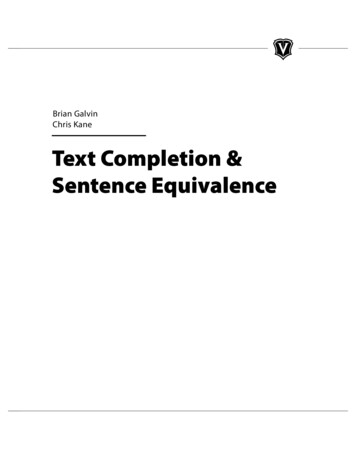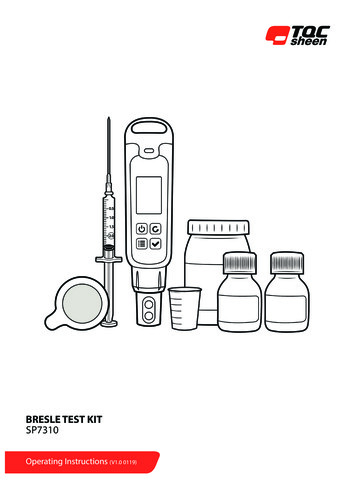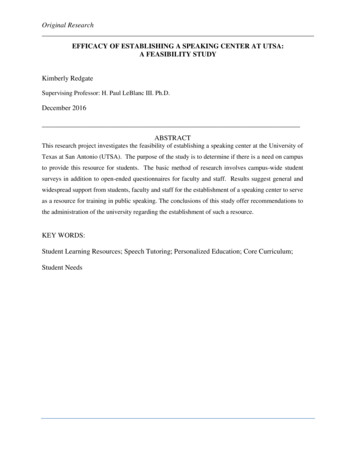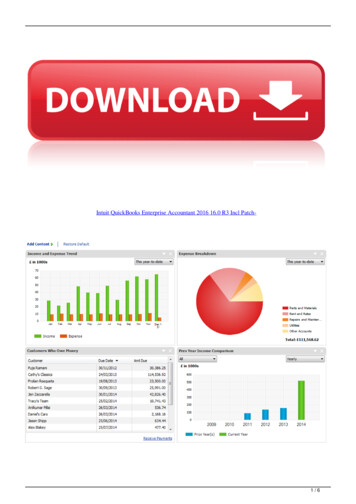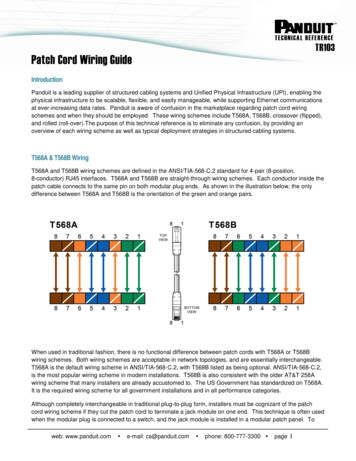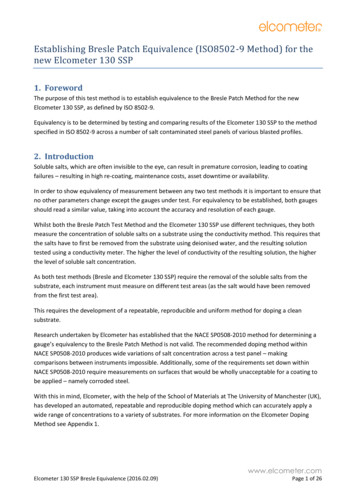
Transcription
Establishing Bresle Patch Equivalence (ISO8502-9 Method) for thenew Elcometer 130 SSP1. ForewordThe purpose of this test method is to establish equivalence to the Bresle Patch Method for the newElcometer 130 SSP, as defined by ISO 8502-9.Equivalency is to be determined by testing and comparing results of the Elcometer 130 SSP to the methodspecified in ISO 8502-9 across a number of salt contaminated steel panels of various blasted profiles.2. IntroductionSoluble salts, which are often invisible to the eye, can result in premature corrosion, leading to coatingfailures – resulting in high re-coating, maintenance costs, asset downtime or availability.In order to show equivalency of measurement between any two test methods it is important to ensure thatno other parameters change except the gauges under test. For equivalency to be established, both gaugesshould read a similar value, taking into account the accuracy and resolution of each gauge.Whilst both the Bresle Patch Test Method and the Elcometer 130 SSP use different techniques, they bothmeasure the concentration of soluble salts on a substrate using the conductivity method. This requires thatthe salts have to first be removed from the substrate using deionised water, and the resulting solutiontested using a conductivity meter. The higher the level of conductivity of the resulting solution, the higherthe level of soluble salt concentration.As both test methods (Bresle and Elcometer 130 SSP) require the removal of the soluble salts from thesubstrate, each instrument must measure on different test areas (as the salt would have been removedfrom the first test area).This requires the development of a repeatable, reproducible and uniform method for doping a cleansubstrate.Research undertaken by Elcometer has established that the NACE SP0508-2010 method for determining agauge’s equivalency to the Bresle Patch Method is not valid. The recommended doping method withinNACE SP0508-2010 produces wide variations of salt concentration across a test panel – makingcomparisons between instruments impossible. Additionally, some of the requirements set down withinNACE SP0508-2010 require measurements on surfaces that would be wholly unacceptable for a coating tobe applied – namely corroded steel.With this in mind, Elcometer, with the help of the School of Materials at The University of Manchester (UK),has developed an automated, repeatable and reproducible doping method which can accurately apply awide range of concentrations to a variety of substrates. For more information on the Elcometer DopingMethod see Appendix 1.www.elcometer.comElcometer 130 SSP Bresle Equivalence (2016.02.09)Page 1 of 26
In addition to developing an automated, more consistent doping method, new parameters for establishingequivalency have been developed which are more appropriate to the industrial application in question,incorporating salt concentration and surface profile.In order to ensure impartiality of the test results, Mr C Molloy, an undergraduate in BSc Physics at theUniversity of Edinburgh, was brought in to independently undertake the tests and generate the report.3. MethodThe following test considerations have been used to establish equivalency to the Bresle Test Patch method.3.1.Surface Salt ConcentrationThe level of ‘acceptable’ threshold concentration levels of soluble salts on a ferrous substrate, withinthe Protective Coatings Industry, are as follows:NAVSEANORSOKDNVIMO009-32 FY-12M-501RP-F102MSC.215(82) & MSC.244(83)30 – 50 mg/m²20 – 50 mg/m²20 mg/m²50 mg/m²To determine equivalency, this test method will dope panels at five ranges of surface salt concentrationlevels:1)2)3)4)5)15 mg/m2 to 25 mg/m225 mg/m2 to 35 mg/m235 mg/m2 to 45 mg/m245 mg/m2 to 55 mg/m2 55 mg/m23.2.Salt RatioEach panel will be immersed in deionised water to remove all residual soluble salts and impurities priorto the doping process. The salt solution used will be industry recognised reference for salts, as definedby NACE SP0508-2010.The following mass ratio of salts shall be used: 24.3% Na2SO422.1% NaNO353.6% NaClDeionised water with a maximum conductivity of 3.00 µS/cm shall be used for both the Bresle PatchTest Method and the Elcometer 130 SSP. Any background conductivity will be measured, recorded anddeducted from the measurements.www.elcometer.comElcometer 130 SSP Bresle Equivalence (2016.02.09)Page 2 of 26
3.3.Surface ProfileCommon practice within the United States of America dictates that coatings are only applied to blastcleaned surfaces, free of rust or corrosion. Blasted profiles within the Protective Coatings Industrytypically have a nominal peak-to-valley height of either 50 µm, 75 µm or 100 µm (2.0, 3.0 and 4.0 mils).European practice may also apply a protective coating up to a nominal 150 µm (6 mils). This practice isbeing considered in the US as well.To determine equivalency, this test method will dope panels at the following nominal steel grit blastprofiles: 25 to 50 µm (1.0 to 2.0 mils)50 to 75 µm (2.0 to 3.0 mils)75 to 150 µm (3.0 to 6.0 mils)In addition to blasted profiles, a clean coated panel will also be tested to establish equivalency forinter-coat assessment.The blasted profile of each uncoated steel panel will be measured using a certified Elcometer 224CDigital Surface Profile Gauge (using the average of 40 measurements on each panel), to determine theaverage peak-to-valley height, in accordance with ASTM D 4417 Method B.3.4.Preparation of Salt Contaminated Test PanelsThe test panels shall be prepared to the specified surface salt density levels using the followingparameters: Test panel size: 300 x 400 mm (11.81 x 15.75 inches)Clean the test panels via immersion in deionised waterDry the panel rapidly by blowing off the water with a heat gun (to reduce flash rusting).Each test panel will be nominally contaminated as follows:o 3 µl of salt solution spaced on a 4 mm grid across the test panel.3.5.Method of Doping of Test PanelsThis section lists the doping method of the test panel. Place the test panels onto a heating elementSet the heating element’s temperature controller to 70 C and leave the temperature tostabilise for two minutes after the temperature controller has met the target value.Initiate the robot software with the gridded programme which takes just short of 3 hours tocomplete.Upon completion remove the panel from the heating element (protective gloves mayberequired!)The Panels will be carried to a nearby test area in an enclosed plastic box.The Panels will be kept in the enclosed plastic box until they are tested.The measurements will be taken within 72 hours of the completion of the salt contaminationprocess.All measurements will be completed in the same test area.www.elcometer.comElcometer 130 SSP Bresle Equivalence (2016.02.09)Page 3 of 26
3.6.Arrangement of Bresle Patches & Elcometer 130 SSP Filter PapersEach Test Panel will be split into 4 test areas of 150 x 200 mm (5.91 x 7.87 inches). 4 x Bresle patches(B1, B2, B3, B4) and 1 x Elcometer 130 SSP filter paper (FP1) will be applied to each test area in thefollowing arrangement: Test Panel 1Test Panel 2 B3 &B1B1B1B3FP1FP1B4 &B2B2B4B1B3 &B1B1B3 B2FP1FP1B4 &B2B2B2 Test Panel 3B4 Test Panel 4 Figure 1 : Bresle Patch and Elcometer 130 SSP LayoutAs Bresle patches can leak under test, in order to preserve the area under test, all four Bresle patcheswill be adhered to the doped test panel. The correctly prepared Elcometer 130 SSP filter paper will thenbe applied and measured in accordance with the manufacturer’s instructions. In this way, the foamseal around each Bresle patch will preserve the doped surface during the Elcometer 130 SSP filter papertest. Each Bresle patch will then be tested in turn.Whilst each Bresle Test Patch provides a single value, the Elcometer 130 SSP measures and records fourBresle equivalent areas and the average of all four (4) patches. All measurements will be recorded.Ambient temperature and relative humidity will be recorded prior to testing. All testing will be carriedout in laboratory conditions.3.7.Test MeasurementsWhilst all efforts have been taken to ensure each test panel is consistently doped, and each test iscarried out under laboratory conditions, in the eventuality that a single reading (either Bresle Patch or aBresle Equivalent area) is significantly different to the surrounding measurements on the test area, thetest panel will be treated as invalid and discarded. The measurement results will be recordedseparately for information purposes only.In order to establish equivalency between the Bresle Patch Test Method and the Elcometer 130 SSP,four (4) valid test areas will be undertaken for each concentration and for each surface profile.www.elcometer.comElcometer 130 SSP Bresle Equivalence (2016.02.09)Page 4 of 26
3.8.Background contaminationWhilst every effort will be made to clean each test panel prior to doping (emersion in deionised water),there are other background contaminants to take into consideration:Bresle patch contaminationBresle patches can suffer from different levels of background contamination. The followingmethod will be used to determine the background contamination of the Bresle patch batch. Thismethod is to be used as it is simpler, minimises the risk of any liquid leakage during the test andmore accurately identifies the contamination of a test patch, not a mix of the test patch and anycontaminants that may be on the glass. Bresle patches from boxes of 25 will be used. As every doped test panel will require 12Bresle patches, a spare Bresle patch will be available each time that the testing of two testpanels is completed. This spare Bresle patch will be used to measure the Bresle patchbackground contamination.Remove the foam centre from the patch, and fold it in half so that the adhesive edges arestuck together. Squeeze the centre section of the patch as it is folded to remove themajority of the air from the centre. Press the edges tightly together to ensure it is sealed.Using 3 ml of deionised water, inject into the cavity of the folded Bresle patch.Figure 2 : Determining the Bresle Patch Contamination Agitate for 90 seconds, remove the contaminated water and measure its conductivity.The patch contamination can be calculated as follows:𝛾(𝑝𝑎𝑡𝑐ℎ ��) 𝛾(𝑒𝑥𝑡𝑟𝑎𝑐𝑡𝑒𝑑 𝑠𝑜𝑙𝑢𝑡𝑖𝑜𝑛) 𝛾(𝑖𝑛𝑗𝑒𝑐𝑡𝑒𝑑 ��𝑡𝑐ℎ ��) conductivity attributable to patch contamination in µS/cm𝛾(𝑖𝑛𝑗𝑒𝑐𝑡𝑒𝑑 𝑠𝑜𝑙𝑢𝑡𝑖𝑜𝑛) conductivity of the injected solution in µS/cm𝛾(𝑒𝑥𝑡𝑟𝑎𝑐𝑡𝑒𝑑 𝑠𝑜𝑙𝑢𝑡𝑖𝑜𝑛) conductivity of the extracted solution in µS/cmThen convert the patch contamination conductivity value to an equivalent salt densityusing the equation:𝜌𝐴 𝑐 𝑉𝐴 𝑦 5 * 3/12.5 * y 1.2 * yWhere:𝜌𝐴 is the equivalent surface salt density of the salts in mg/m-2c 5.0 kg*m *S2A 12.5 cm (surface area of a A-1250 Bresle patch)2V Volume of injected solution (3 ml)𝑦 patch contamination conductivity inµS/cmwww.elcometer.comElcometer 130 SSP Bresle Equivalence (2016.02.09)Page 5 of 26
Record the equivalent surface salt density of this contamination and use it to calculate anaverage background salt density value for each batch of Bresle patches used.Deionised Water concentrationDeionised water with a maximum conductivity of 3.00 µS/cm shall be used for both the BreslePatch Test Method and the Elcometer 130 SSP tests. Any background conductivity will bemeasured, recorded and deducted from the Bresle Patch Test Method measurements. TheElcometer 130 SSP will automatically adjust its measurement to take account of this backgroundconductivity once the “offset procedure” has been followed. See section 3.8.3Elcometer 130 SSP filter paper and water, offset procedure:As per the manufacturer’s operating instructions, when a new box of filter papers is opened or anew container of deionised water is used, the filter paper and deionised water offset needs to beset on the Elcometer 130 SSP. Extract, with tweezers, a filter paper from the box.Place the dry filter paper onto the Elcometer 130 magnetic disc - which has been cleanedusing deionised water and sensor wipes.Fill the syringe completely with deionised water and discard it. Perform this rinsing threetimes.Fill the syringe with 1.6 ml of deionised water. Spread the water, from the syringe, evenlyacross the whole of the Elcometer 130 SSP filter paper. Best achieving by starting in themiddle of the filter paper and working out two the edge using multiple drops. Then tilt themagnetic disc as necessary until the water is evenly spread across the filter paper.Place the magnetic disc with filter paper onto the Elcometer 130 SSP measuring electrodes(which has been cleaned using deionised water and sensor wipes).On the gauge select Menu\Setup\Calibration\Calibration Offset and follow the screeninstructions. When complete the gauge reports “Calibrated”, press Ok and return to theNormal Reading Screen.With the magnetic disc and filter paper on the measuring electrodes take a reading. Checkthat the reading is no more than 1 – 2 mg/m2 (0.1 – 0.2µg/cm2)www.elcometer.comElcometer 130 SSP Bresle Equivalence (2016.02.09)Page 6 of 26
4. Data AnalysisWhen the results are taken they will conform to the following criteria:4.1.Elcometer130SSP to Bresle Patch Data analysisTo be deemed equivalent to the Bresle Patch Method the Elcometer 130SSP results shall meet thefollowing requirements:The average of the four Bresle readings in each test area will be within 9mg/m2 of the averagefilter paper reading for that area (which ever is the greatest).4.2.Conversion FactorAn internal conversion factor will be used to bring the Elcometer 130 SSP results in line with themeasured Bresle Patch Method results across all surfaces and all salt densities. The conversion factorwill not be reported.5. Results SummaryThe Results displayed in Appendix two represent the average values of 5 test areas – a test area is definedas 4 Bresle Patches and 1 Elcometer 130 SSP
3.2.Salt Ratio Each panel will be immersed in deionised water to remove all residual soluble salts and impurities prior to the doping process. The salt solution used will be industry recognised reference for salts, as defined by NACE SP0508-2010. The following mass ratio of salts shall be used: 24.3% Na 2 SO 4 22.1% NaNO 3 53.6% NaClFile Size: 2MBPage Count: 26
